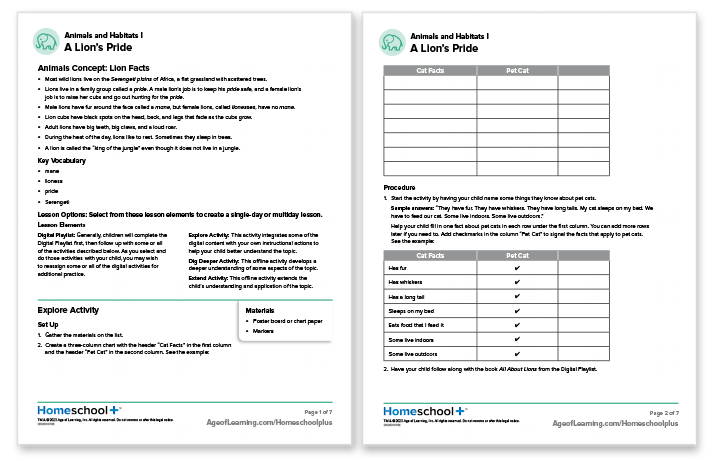COURSE
Animals & Habitats I
Animals & Habitats I will help your child develop an understanding of concepts such as:
- Physical Characteristics
- Behaviors
- Habitat
- Environmental Differences
- Life Cycle
COURSE OVERVIEW
Enhance your child’s understanding of the animal kingdom while sparking their imagination. Through fun, engaging activities, such as read-along books, puzzles, and other interactive Learning Activities, this course is designed to educate, illuminate, and foster an appreciation of animals and the environments in which they live.
Upon completion of this course’s 18 lessons, your child will have become familiar with the adaptations (characteristics and behaviors) of a wide variety of animals, both domestic and wild. As your child learns about the habitats of those animals, they will also become more familiar with several of Earth’s major types of environments.
LESSON 1: PENGUINS
Teach your child about the natural behaviors of penguins in their habitats. Your child will learn about penguins’ distinct physical features and the behaviors that allow them to thrive in cold and marine environments.
LESSON 2: LIONS
Take your child on an adventure to the Serengeti, where they will learn about lions and their place in the animal kingdom. Teach your child about lion habitats and how lion behavior and social structures help them survive in their surroundings.
LESSON 3: HORSES
Horses have played a significant role in human society for thousands of years. By studying their physical characteristics and behaviors, and their roles throughout history and in the present, your child will become able to better understand their roles in transportation, farming, sports, and therapy.
LESSON 4: ELEPHANTS
Teach your child about the largest land animal on Earth—the elephant! From distinctive features such as big ears, saggy skin, four thick legs, two tusks, and a powerful trunk, to complex social behaviors and advanced cognitive abilities, your child will learn why these animals are so admired and loved by the people who live and work with them.
LESSON 5: FLAMINGOS
What turns flamingos pink? Why do they stand on one leg? Your child will learn the answers to these and other questions about this one-of-a-kind bird through activities that explore their characteristics, behaviors, and habitats.
LESSON 6: MONKEYS
Open your child’s eyes to the fascinating social organization of monkey populations. Your child will also learn details about their diet, their physical characteristics, and other adaptations.
LESSON 7: CHICKENS
Did you know that chickens can fly? They can, just not very far. Teach your child all about these barnyard birds, including their body features, the differences between hens and roosters, and their life cycle.
LESSON 8: GIRAFFES
Give your child a window into the world of giraffes and how their long neck, long legs, and spots allow them to find their favorite food and survive in their natural habitat.
LESSON 9: COWS
Teach your child how cows are raised on farms to provide us with meat, milk, and other dairy products. Your child will also learn about their life stages.
LESSON 10: GORILLAS
Explore the world of gorillas! Your child will learn about the characteristics and behavior of these majestic creatures, including their impressive physical size and natural habitat in African mountains and rainforests.
LESSON 11: ZEBRAS
Learn about zebras together as you teach your child why their manes stand up, how their stripes are helpful both in identification and protection, and how they keep their young safe in their herds.
LESSON 12: CAMELS
Why do camels have long eyelashes? Learn about the adaptations and characteristics that allow camels to survive in desert environments and how they protect their eyes, nose, ears, and feet from harsh desert conditions—and, of course, learn all about their humps!
LESSON 13: OSTRICHES
Get to know the largest birds in the world! From their huge eggs to their long necks to their strong legs and clawed toes, ostriches are ideally adapted to find food, fight off predators, and raise babies in the places where they live.
LESSON 14: SHEEP
Shepherds have been guarding their flocks for thousands of years, and you can help your child understand why in this lesson about sheep and agriculture. Your child will learn about rams, ewes, and lambs, fleece and its uses, and how and when sheep are carefully sheared for wool.
LESSON 15: GIANT ANTEATERS
If ever an animal was built to find its favorite food, it’s the anteater! In this lesson, your child will learn about their special diet (it’s not just ants), and how they use their noses, claws and two-foot tongues to find and slurp down up to 35,000 ants a day.
LESSON 16: SEALS
With a scientific name that means “flipper footed,” seals are one of the few types of mammals that can get around on land and in the ocean. In this lesson, your child will learn that seals are aided in their survival not only by their flippers, but also by layers of fat and fur that protect these warm-blooded animals from freezing ocean temperatures.
LESSON 17: IMPALAS
Take your child to the grasslands of Africa as you teach them all about these deer-like animals. Your child will learn about their physical features, such as their long red fur, distinct markings, and why some have antlers.
LESSON 18: TROPICAL BIRDS
Rainforests are home to more forms of life than any other type of environment, and your child will love finding out more about some of the most beautiful examples of that in this lesson about tropical birds. Your child will learn about their habitat, physical features, and social structure within flocks.
